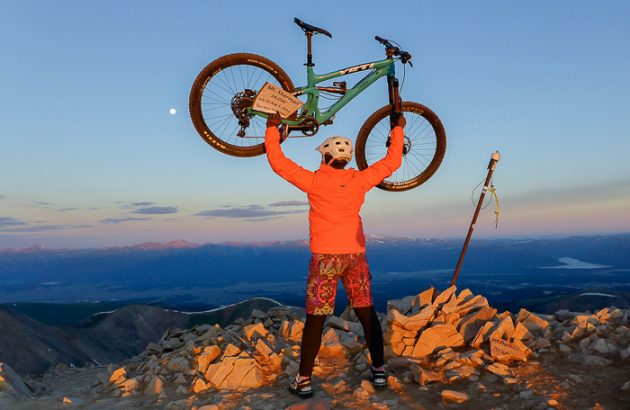The Journeywoman
Originally posted on October 6, 2015 at 13:02 pmJessica Martin arrived at the top of Pikes Peak near Colorado Springs after hiking and riding a 13-mile, 8000-foot vertical trail. She was wearing a multi-colored tutu because “bikes are about fun; this is supposed to be fun.” Alongside two friends she popped champagne, ate donuts and took a few photographs, but otherwise there was little fanfare around what she had achieved.
It was late morning on Sept. 24, 2015, and Martin, a not-famous, not-professional mountain biker uninterested in self-promotion, had just become the first woman to summit all of Colorado’s legal-to-ride 14,000-foot peaks by mountain bike.

A few days later, Martin and her high school chemistry teacher (the second woman to ski all of Colorado’s fourteeners) would summit Mt. Elbert via bike before enjoying one of the better trail descents. Martin had already ridden Elbert, but that was back in 2012 and she was determined to tackle all of them in a single season.
The standout thing about Martin is that she’s a privateer and has only been mountain biking for about five years. This is an honest-to-goodness, “she’s just like you and me” story, with a warm-spirited 29-year-old at the center doing something purely for passion’s sake on her days off, with her own money and by the power of her own volition.
And—as someone who is unsponsored—she rode each fourteener on a bike that our current trends would demonize as wholly inappropriate for the job: an aluminum 2011 Yeti ASR-7 with a 180mm FOX 36 fork that weighs a whopping 34 pounds. (For Mt. Sherman, she got to borrow a new carbon Yeti.)
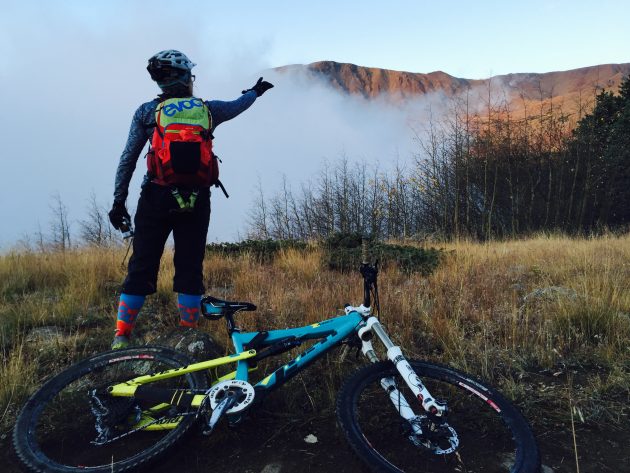
Martin owns a home in Golden, Colorado, where she works for Donor Alliance doing the delicate job of tissue and organ recovery. She also occasionally helps out at the International Mountain Bicycling Association (IMBA), which helped strengthen her ethos of ethical riding.
Martin spent countless hours painstakingly ascertaining the legality of mountain biking on each peak. Twenty-seven of Colorado’s fourteeners (there are 53 total) are outside of Wilderness areas—places with no bicycle access whatsoever—but many of those were still tossups and required endless research down Internet rabbit holes and multiple phone calls to overseeing land managers.
“I always wanted to stick to riding what I knew was absolutely legal. I’m not here to stir any pots or start any user group conflicts, and I don’t want anyone to be able to come back and question my motives,” she said. “I know people are going to look up to this and I already have riders asking for beta. I simply wanted to celebrate what we are able to ride.”
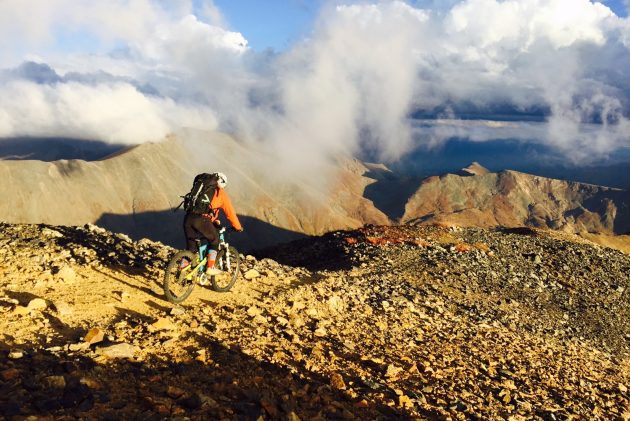
The number of legal fourteeners Martin came up with is 14, and she took her 34-pound Yeti to the top of every single one between July 31 and October 2, even though it meant carrying the bike on her back as she scrambled across precarious scree and talus fields thousands of feet above tree line (which is roughly 12,000 feet).
“The first two peaks I did, I was able to summit with my bike so it just wasn’t a question that I would take it to the top of each one. My bike is my team and it gets me as far as it can,” said Martin. “But it’s also from my backcountry splitboarding and mountaineering mindset. In those activities, you never leave gear behind.”

The obvious question here is, “Why?” Why haul a bicycle into thin air facing treacherous terrain, often-unrideable trails, unpredictable weather, very long hours, early mornings, late nights and lots of cold pizza?
For Martin, the answer has multiple dimensions, each of them personal. It struck me as remarkable—especially in the face of criticism that mountain bikers don’t belong in the backcountry and can’t appreciate it—that her answer sounds much like one from any nature-loving pioneer adventurer, be they a climber, mountaineer, backpacker or otherwise: “It’s the type of riding that makes me come alive,” she said. “I love being completely out in nature, vulnerable, exposed and discovering. It’s not that this is the best way to experience life. As long as you find the thing that makes you feel alive, you’re winning.”
With a smile, she added: “Weeknight group rides just don’t do that for me.”
Martin’s project started in 2012 when she and her ex-boyfriend tackled Mt. Elbert (Colorado’s highest peak) after hearing of some friends doing it by bike. The trail was almost entirely rideable on the way down—so good that they had to stop a few times to let their brakes cool.
“It’s impossible to describe the feeling up there when you’re looking down and knowing that you’re literally above everything in the state and that the trail below is you is totally rideable,” she said. “The summit is the most profound part of the journey.”

Elbert planted a seed that took a while to develop. Last year, Martin attempted to ride Mt. Sherman but hit snow near the top that was so steep it was impassible in cycling shoes, so that was the first one she went back for this year on July 31. Under a full moon, Martin started her trek at 3:15 a.m., arrived at the top for sunrise and was back at her car by 8:30.
It was the fastest summit, by far. She admits that Elbert and Sherman tricked her into thinking the adventure would be easier than it was, but they also committed her to figuring out how to tackle the project of riding up and down each accessible fourteener. Martin freely admits that she wasn’t sure it would be possible, but wanted to give it a go, anyway.
The journey took on a new meaning for Martin in October 2014, when she crashed on a technical-but-familiar trail in Moab, Utah. She broke her arm so severely that it required surgery, lots of metal and four months of absolutely no bike riding to put the broken bones back together.
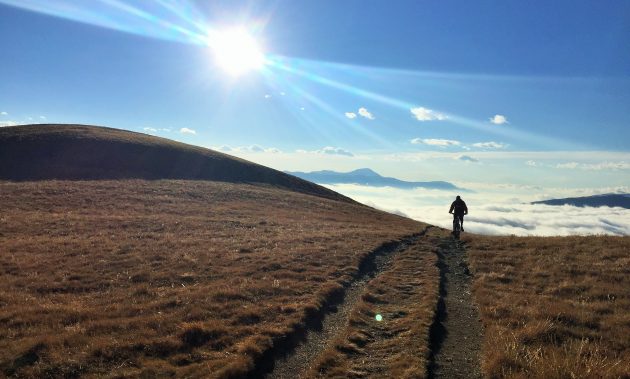
“It’s insane how the mental impact of that wreck resonated. There’s not a single ride when I don’t think about the crash, whether I feel fear or just feel the hardware vibrating in my arm,” she said. “The fourteeners became a way to challenge myself and test my bravery, but I accept that some risks aren’t worth it and I took a very cautious approach even though I was pushing my limits. I had nothing to prove, but there’s something unique about dealing with the consequences of the terrain you are in and overcoming your fears.”
The project wasn’t entirely straightforward. Though Martin had occasional trailhead-based support or company from friends, she undertook several of the peaks alone (it’s simply not easy to find people with the time, gear and ability to ride bikes up and down fourteeners on Thursdays or Fridays). The most difficult was Mt. Princeton, which turned into an 18-hour epic. This is how Martin described the journey on her Facebook wall:

Yesterday was a test of my limits like I have never had. I set out on a solo mission on Mt Princeton. I pedaled 4 miles up a dirt road to the start of the trail. The singletrack stopped as fast as it started and it quickly became a slow slog, shouldering the bike almost the whole way through scree and talus fields. My spirit suffered with every step I took, knowing that literally none of what I was climbing was rideable on the way down. My stubborn determination pushed me to the summit after a slow 7 hour slog with my 34 pound stallion of a bike. I celebrated with some warm coffee and a juicy palisade peach.
I knew the descent was going to be slower and more challenging than the ascent but I had no idea what I was in for. It was pure treachery, slowly picking my way down the endless fields of unrideable rock. I became so deflated as the clock ticked and I looked down at how far I had to go. Having the bike in tow was unwieldy as I maneuvered through the rocky terrain and, to top it off, I had developed a pressure sore on my ankle during the climb and I was now limping with every step. Sunset was fast approaching and I knew I would be finishing in the dark. I was able to get texts out to friends, got head lamps prepped and layered up for the dropping temps and wind.
Before long I was scrambling in complete darkness. Fear set in and I entered survival mode. I was alone, thirsty, hungry and scared. One misstep could send me or my bike tumbling down the mountain and all I had was a headlamp to guide me from one cairn to the next. I remember coming around a corner and seeing the rocky trail fade into singletrack and I was overcome with relief, the cessation of suffering was near.
It wasn’t long until the trail met the rutted 4WD road and I made my way down to where my friend Joey was staged with relief goodies. After a few minutes in a warm truck, electrolytes, snacks and a better head lamp, I [pedaled] down the road to complete the ride. My adventure comprised 18 hours, 15 miles, 5,783 feet of vertical, two bruised toenails, one bum ankle and one happy Jess overwhelmed with gratitude for persevering and surviving an epic solo adventure.
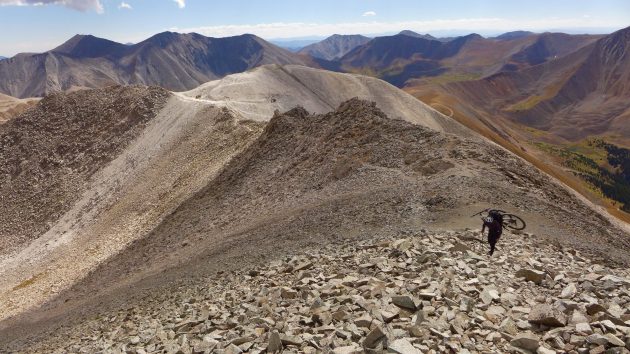
“Would I do it again? No. My grandmother could have come down Princeton faster because I had to pick up my bike and set it down again with every step, but there was no way I was giving up suffering in the throes of it,” said Martin when I asked her about Princeton. “Every time I got back to my car after finishing another fourteener, I arrived a changed person that was elated and inspired. Whether it’s trusting yourself or finding appreciation and respect for nature, or enjoying a mind-blowing descent, there was a combination of things that changed me each time.”
Most of the fourteeners simply aren’t great mountain bike rides: they are serviced by legacy trails, meaning the routes are so steep and rocky you’d have to have super-human strength to climb them and be “Danny Macaskill on steroids” to maneuver down. Martin can count on one hand the number of peaks she would recommend if you’re looking for an exciting descent. “A fun descent is the best part but the completion, in one piece, and being able to start planning the next one…that was the best.”

Martin is quick to point out that if you’re willing to spend some timing hiking with your bike, it’s worth the suffering. She strongly recommends you don’t attempt fourteeners by bike during peak hours or on weekends when the crowds could make your descent almost impossible to ride. Her nontraditional work schedule allowed her to be out on weekdays but, even then, she was still encountering groups of hikers.
She always made a point to pull off the trail to let hikers pass and strike up conversations whenever possible, which often resulted in exchanges of information as more and more hikers wanted to keep up with her progress. Martin was “awestruck” and humbled by the on-trail support she received, and emphasized that she was conscious of giving the (often hard-core) hikers who climb fourteeners a positive backcountry trail experience with a mountain biker.
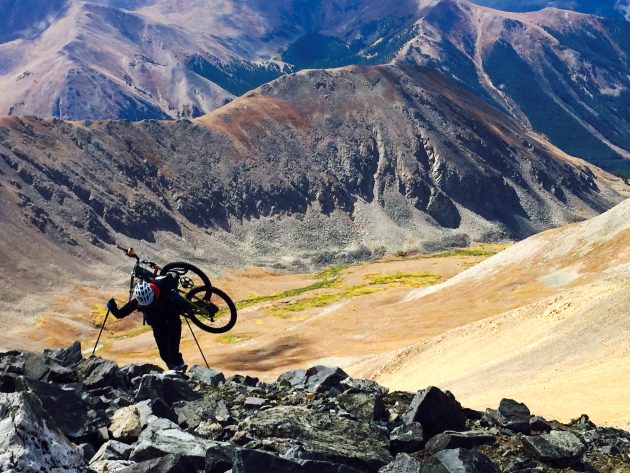
“I didn’t care how long it took me. The personal interaction with others is more important than the actual ride,” she said. “Of course we’d all love to shred hard on the way down, but I would rather maintain responsible riding etiquette than scare people.”
Martin credits her success in part to the fact she was never hard-focused on setting a record, and that these rides were some of her first where she had to do all of the planning, preparation and be wholly self-sufficient. She moved methodically up and down the mountains; took photos to remember paths through rock fields after dirt trails disappeared; carried several pounds of extra clothing, backup batteries, real food, multiple lights and a bivvy sack; did extensive pre-trip planning and regularly texted people along the route (most peaks have great cell service above tree line).
“It was simply a personal goal and was never about making a splash of publicity. By the time I finished, I realized that it took only two months to accomplish the most profound and meaningful thing I have ever done,” she said. “I will never be the fastest or best technical rider, and it’s hard to set big goals in mountain biking anymore, but this was something where I could grow, thrive and come alive.”
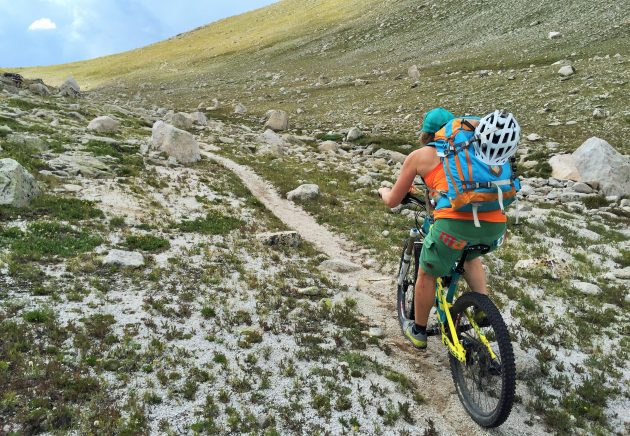
Martin’s fourteenth fourteener attempt, Pikes Peak, began imperfectly. The parking lot was already packed at 5 a.m., forcing her to start later than planned. On that morning, she was feeling added pressure because two friends would be waiting at the top to ride the mostly-bikeable descent with her in celebration.
She was running on very little sleep, nerves, excitement and the tiredness of having done an 18-mile mountain bike ride the day before. Martin shrugs with a sheepish smile as she mentions that, “It was hard to turn down an autumn ride on a trail I really enjoy.”

The bottom of the trail has several stairs, which can be a discouraging way to begin a very long climb. The first several miles were also packed with hikers. Pikes Peak—thanks to its accessibility from a metro area, multiple vehicle access options and (perhaps) the presence of a donut shop on the peak—is one of the most popular fourteeners.
Eventually she passed a junction and the trail cleared out, offering a decent number of ridable sections. At one point, Martin ran into a group of women hikers on their way down. “One of them and said that once they realized I was a girl coming in the distance they said to each other, ‘Fuck yea, sister! That’s one strong chick!’”
Martin said she felt like she was moving slower than molasses but when she finally looked at her Strava data after the ride, it turned out she had beat the reigning Queen of the Mountain by one minute (total riding time 6 hours and 41 minutes).
“With a heavy ass pack and no sleep, it’s amazing what your body will do when you’re committed to something,” she said. “I never went into it looking for that; the journey was never about competition.” But it was a nice capstone to a hell of an adventure.
The trail on Pikes Peak is like kitty litter: sand and decomposed granite. The final mile to and from the top is completely covered in giant rocks so that it’s wholly unrideable. Martin was shaking with joy as she reached the top. The cog railway happened to be arriving at the same time, so her final summit push was greeted by the train’s honking as her friends cheered her on and presented her with champagne and fresh donuts.
They didn’t hang around long before taking off on descent. “I was grinning the whole way down,” said Martin, who chased the wheel of Tammy Donahugh, a friend and former professional mountain biker.
“She’s one of my mountain bike heroes, so I was in awe getting to ride with her,” said Martin. “Just being able to ride with people I care about brought it all back to the bigger picture of the community of mountain biking; that’s what matters.”
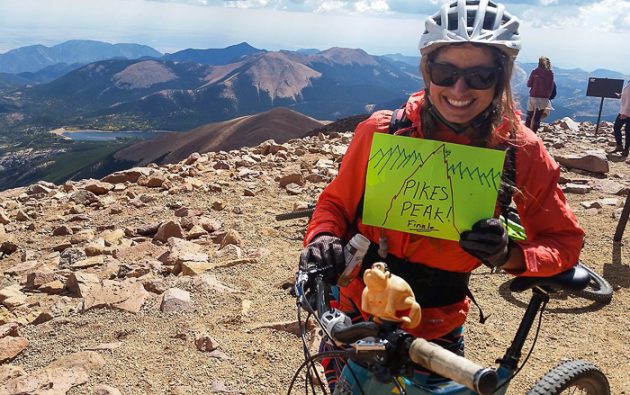
On the drive home, Martin looked back at Pikes Peak in her rear view mirror and started bawling. “I was that chick crying in a car and then laughing at myself. People were probably thinking I’d just been broken up with,” she said. “Now, every day it’s like ‘wow, I did it,’ and it takes on a different form.”
So what’s next? Since most of her free days were devoted to the fourteener project, Martin is looking forward to getting her life back and socializing with people she hasn’t seen in nearly three months. Other than that, she’s excited for another season of backcountry snowboarding and will spend some time processing the journey.
“You can find inspiration and strength outside of your comfort zone and I had no idea I was capable of doing that,” she said. “It’s so cliché, but life is fucking short and you have to find a way to take advantage of our limited time here. This is one way I can move mountain biking forward and show what women are capable of doing.”
